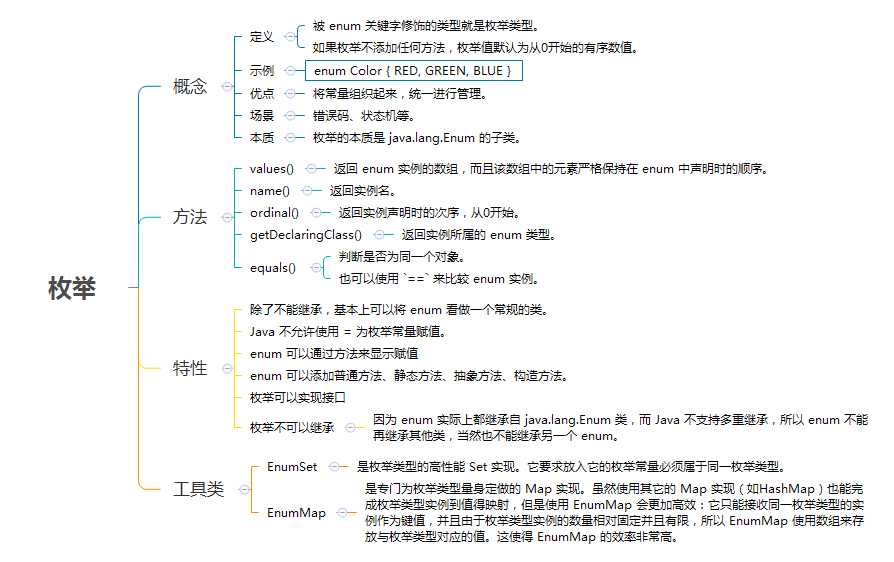标签:== next 对象 val 常量 实例 tom etc 判断
在单例模式中,一个类只有一个实例。而枚举其实就是多例,一个类有多个实例,但实例的个数不是无穷的,是有限个数的。例如word文档的对齐方式有几种:左对齐、居中对齐、右对齐。开车的方向有几种:前、后、左、右!
我们称呼枚举类中实例为枚举项!一般一个枚举类的枚举项的个数不应该太多,如果一个枚举类有30个枚举项就太多了!

enum 的全称为 enumeration, 是 JDK 1.5 中引入的新特性。
在Java中,被 enum 关键字修饰的类型就是枚举类型。形式如下:
enum Color { RED, GREEN, BLUE }
如果枚举不添加任何方法,枚举值默认为从0开始的有序数值。以 Color 枚举类型举例,它的枚举常量依次为 RED:0,GREEN:1,BLUE:2。
枚举的好处:可以将常量组织起来,统一进行管理。
枚举的典型应用场景:错误码、状态机等。
在enum中,提供了一些基本方法:
values():返回 enum 实例的数组,而且该数组中的元素严格保持在 enum 中声明时的顺序。
name():返回实例名。
ordinal():返回实例声明时的次序,从0开始。
getDeclaringClass():返回实例所属的 enum 类型。
equals() :判断是否为同一个对象。
可以使用 == 来比较enum实例。
此外,java.lang.Enum实现了Comparable和 Serializable 接口,所以也提供 compareTo() 方法。
例:展示enum的基本方法
public class EnumMethodDemo { enum Color {RED, GREEN, BLUE;} enum Size {BIG, MIDDLE, SMALL;} public static void main(String args[]) { System.out.println("=========== Print all Color ==========="); for (Color c : Color.values()) { System.out.println(c + " ordinal: " + c.ordinal()); } System.out.println("=========== Print all Size ==========="); for (Size s : Size.values()) { System.out.println(s + " ordinal: " + s.ordinal()); } Color green = Color.GREEN; System.out.println("green name(): " + green.name()); System.out.println("green getDeclaringClass(): " + green.getDeclaringClass()); System.out.println("green hashCode(): " + green.hashCode()); System.out.println("green compareTo Color.GREEN: " + green.compareTo(Color.GREEN)); System.out.println("green equals Color.GREEN: " + green.equals(Color.GREEN)); System.out.println("green equals Size.MIDDLE: " + green.equals(Size.MIDDLE)); System.out.println("green equals 1: " + green.equals(1)); System.out.format("green == Color.BLUE: %b\n", green == Color.BLUE); } }
输出:
=========== Print all Color =========== RED ordinal: 0 GREEN ordinal: 1 BLUE ordinal: 2 =========== Print all Size =========== BIG ordinal: 0 MIDDLE ordinal: 1 SMALL ordinal: 2 green name(): GREEN green getDeclaringClass(): class org.zp.javase.enumeration.EnumDemo$Color green hashCode(): 460141958 green compareTo Color.GREEN: 0 green equals Color.GREEN: true green equals Size.MIDDLE: false green equals 1: false green == Color.BLUE: false
除了不能继承,基本上可以将 enum 看做一个常规的类。
1. 枚举可以添加方法
枚举值默认为从0开始的有序数值 。那么问题来了:如何为枚举显示的赋值。
(1) Java 不允许使用 = 为枚举常量赋值
(2) 枚举可以添加普通方法、静态方法、抽象方法、构造方法
Java 虽然不能直接为实例赋值,但是它有更优秀的解决方案:为 enum 添加方法来间接实现显示赋值。
创建 enum 时,可以为其添加多种方法,甚至可以为其添加构造方法。
注意一个细节:如果要为enum定义方法,那么必须在enum的最后一个实例尾部添加一个分号。此外,在enum中,必须先定义实例,不能将字段或方法定义在实例前面。否则,编译器会报错。
例:全面展示如何在枚举中定义普通方法、静态方法、抽象方法、构造方法
public enum ErrorCode { OK(0) { public String getDescription() { return "成功"; } }, ERROR_A(100) { public String getDescription() { return "错误A"; } }, ERROR_B(200) { public String getDescription() { return "错误B"; } }; private int code; // 构造方法:enum的构造方法只能被声明为private权限或不声明权限 private ErrorCode(int number) { // 构造方法 this.code = number; } public int getCode() { // 普通方法 return code; } // 普通方法 public abstract String getDescription(); // 抽象方法 public static void main(String args[]) { // 静态方法 for (ErrorCode s : ErrorCode.values()) { System.out.println("code: " + s.getCode() + ", description: " + s.getDescription()); } } }
注:上面的例子并不可取,仅仅是为了展示枚举支持定义各种方法。下面是一个简化的例子
public enum ErrorCodeEn { OK(0, "成功"), ERROR_A(100, "错误A"), ERROR_B(200, "错误B"); ErrorCodeEn(int number, String description) { this.code = number; this.description = description; } private int code; private String description; public int getCode() { return code; } public String getDescription() { return description; } public static void main(String args[]) { // 静态方法 for (ErrorCodeEn s : ErrorCodeEn.values()) { System.out.println("code: " + s.getCode() + ", description: " + s.getDescription()); } } }
2. 枚举可以实现接口
enum 可以像一般类一样实现接口。
同样是实现上一节中的错误码枚举类,通过实现接口,可以约束它的方法。
public interface INumberEnum { int getCode(); String getDescription(); } public enum ErrorCodeEn2 implements INumberEnum { OK(0, "成功"), ERROR_A(100, "错误A"), ERROR_B(200, "错误B"); ErrorCodeEn2(int number, String description) { this.code = number; this.description = description; } private int code; private String description; @Override public int getCode() { return code; } @Override public String getDescription() { return description; } }
3. 枚举不可以继承
enum 不可以继承另外一个类,当然,也不能继承另一个 enum 。
因为 enum 实际上都继承自 java.lang.Enum 类,而 Java 不支持多重继承,所以 enum 不能再继承其他类,当然也不能继承另一个 enum。
1. 组织常量
在JDK1.5 之前,在Java中定义常量都是public static final TYPE a; 这样的形式。有了枚举,你可以将有关联关系的常量组织起来,使代码更加易读、安全,并且还可以使用枚举提供的方法。
(1) 枚举声明的格式
注:如果枚举中没有定义方法,也可以在最后一个实例后面加逗号、分号或什么都不加。
下面三种声明形式是等价的:
enum Color { RED, GREEN, BLUE } enum Color { RED, GREEN, BLUE, } enum Color { RED, GREEN, BLUE; }
2. switch 状态机
我们经常使用switch语句来写状态机。JDK7以后,switch已经支持 int、char、String、enum 类型的参数。这几种类型的参数比较起来,使用枚举的switch代码更具有可读性。
enum Signal {RED, YELLOW, GREEN} public static String getTrafficInstruct(Signal signal) { String instruct = "信号灯故障"; switch (signal) { case RED: instruct = "红灯停"; break; case YELLOW: instruct = "黄灯请注意"; break; case GREEN: instruct = "绿灯行"; break; default: break; } return instruct; }
3. 组织枚举
可以将类型相近的枚举通过接口或类组织起来。
但是一般用接口方式进行组织。
原因是:Java接口在编译时会自动为enum类型加上public static修饰符;Java类在编译时会自动为 enum 类型加上static修饰符。看出差异了吗?没错,就是说,在类中组织 enum,如果你不给它修饰为 public,那么只能在本包中进行访问。
(1) 在接口组织enum
public interface Plant { enum Vegetable implements INumberEnum { POTATO(0, "土豆"), TOMATO(0, "西红柿"); Vegetable(int number, String description) { this.code = number; this.description = description; } private int code; private String description; @Override public int getCode() { return 0; } @Override public String getDescription() { return null; } } enum Fruit implements INumberEnum { APPLE(0, "苹果"), ORANGE(0, "桔子"), BANANA(0, "香蕉"); Fruit(int number, String description) { this.code = number; this.description = description; } private int code; private String description; @Override public int getCode() { return 0; } @Override public String getDescription() { return null; } } }
(2) 在类中组织enum
public class Plant2 { public enum Vegetable implements INumberEnum {...} // 省略代码 public enum Fruit implements INumberEnum {...} // 省略代码 }
4. 策略枚举
EffectiveJava中展示了一种策略枚举。这种枚举通过枚举嵌套枚举的方式,将枚举常量分类处理。
这种做法虽然没有switch语句简洁,但是更加安全、灵活。
例:EffectvieJava中的策略枚举范例
enum PayrollDay { MONDAY(PayType.WEEKDAY), TUESDAY(PayType.WEEKDAY), WEDNESDAY( PayType.WEEKDAY), THURSDAY(PayType.WEEKDAY), FRIDAY(PayType.WEEKDAY), SATURDAY( PayType.WEEKEND), SUNDAY(PayType.WEEKEND); private final PayType payType; PayrollDay(PayType payType) { this.payType = payType; } double pay(double hoursWorked, double payRate) { return payType.pay(hoursWorked, payRate); } // 策略枚举 private enum PayType { WEEKDAY { double overtimePay(double hours, double payRate) { return hours <= HOURS_PER_SHIFT ? 0 : (hours - HOURS_PER_SHIFT) * payRate / 2; } }, WEEKEND { double overtimePay(double hours, double payRate) { return hours * payRate / 2; } }; private static final int HOURS_PER_SHIFT = 8; abstract double overtimePay(double hrs, double payRate); double pay(double hoursWorked, double payRate) { double basePay = hoursWorked * payRate; return basePay + overtimePay(hoursWorked, payRate); } } }
测试:
System.out.println("时薪100的人在周五工作8小时的收入:" + PayrollDay.FRIDAY.pay(8.0, 100));
System.out.println("时薪100的人在周六工作8小时的收入:" + PayrollDay.SATURDAY.pay(8.0, 100));
Java 中提供了两个方便操作enum的工具类——EnumSet 和 EnumMap。
EnumSet 是枚举类型的高性能 Set 实现。它要求放入它的枚举常量必须属于同一枚举类型。
EnumMap 是专门为枚举类型量身定做的 Map 实现。虽然使用其它的 Map 实现(如HashMap)也能完成枚举类型实例到值得映射,但是使用 EnumMap 会更加高效:它只能接收同一枚举类型的实例作为键值,并且由于枚举类型实例的数量相对固定并且有限,所以 EnumMap 使用数组来存放与枚举类型对应的值。这使得 EnumMap 的效率非常高。
// EnumSet的使用 System.out.println("EnumSet展示"); EnumSet<ErrorCodeEn> errSet = EnumSet.allOf(ErrorCodeEn.class); for (ErrorCodeEn e : errSet) { System.out.println(e.name() + " : " + e.ordinal()); } // EnumMap的使用 System.out.println("EnumMap展示"); EnumMap<StateMachine.Signal, String> errMap = new EnumMap(StateMachine.Signal.class); errMap.put(StateMachine.Signal.RED, "红灯"); errMap.put(StateMachine.Signal.YELLOW, "黄灯"); errMap.put(StateMachine.Signal.GREEN, "绿灯"); for (Iterator<Map.Entry<StateMachine.Signal, String>> iter = errMap.entrySet().iterator(); iter.hasNext();) { Map.Entry<StateMachine.Signal, String> entry = iter.next(); System.out.println(entry.getKey().name() + " : " + entry.getValue()); }
参考:
https://www.cnblogs.com/jingmoxukong/p/6098351.html
标签:== next 对象 val 常量 实例 tom etc 判断
原文地址:https://www.cnblogs.com/myitnews/p/12936859.html